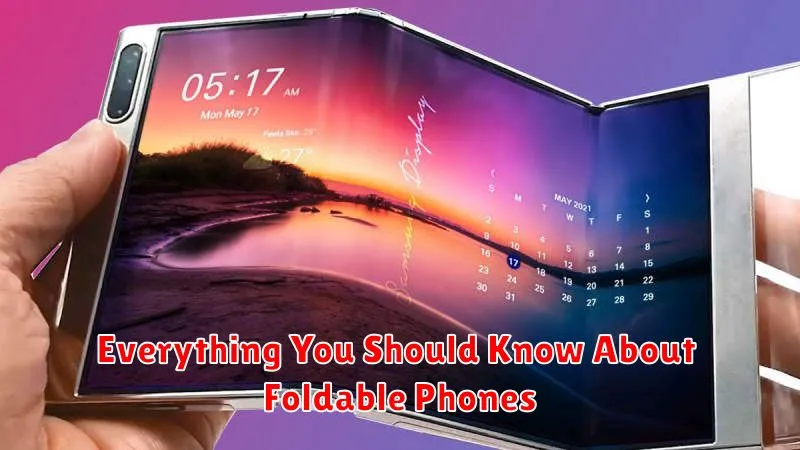Foldable phones have rapidly transitioned from a futuristic concept to a tangible reality in the mobile phone market. These innovative devices, featuring flexible displays that allow them to transform from a traditional smartphone form factor into a larger tablet-like experience, are revolutionizing how we interact with technology. Understanding the nuances of foldable phones, including their various types, benefits, drawbacks, and the leading manufacturers in this cutting-edge space, is crucial for anyone considering embracing this next generation of mobile devices. This article will delve into everything you should know about foldable phones, equipping you with the knowledge to navigate this exciting and rapidly evolving technological landscape.
From the intricacies of foldable phone technology, such as the different folding mechanisms employed, to the practical implications of owning a foldable phone, including app compatibility and durability considerations, this comprehensive guide will cover it all. We will explore the advantages of foldable phones, including enhanced multitasking capabilities and immersive media consumption, as well as address potential concerns surrounding their price, fragility, and long-term performance. Whether you are a tech enthusiast eager to stay ahead of the curve or simply curious about the future of smartphones, this exploration of foldable phones will provide valuable insights into this groundbreaking technology.
What Are Foldable Smartphones?
Foldable smartphones are a relatively new category of mobile devices. They feature flexible displays that allow the phone to be folded in half, transforming from a compact form similar to a traditional smartphone into a larger tablet-like device. This innovative design aims to combine the portability of a smartphone with the expansive screen real estate of a tablet.
This folding capability is achieved through advanced engineering and materials science, utilizing flexible OLED screens and sophisticated hinges. When folded, the display is protected, and the device becomes more pocketable. Unfolded, users gain access to a significantly larger screen area, enhancing experiences like media consumption, multitasking, and gaming.
Key Brands and Devices in the Market
The foldable phone market, while still relatively nascent, is populated by a few key players pushing the boundaries of this technology. Samsung leads the charge with its Galaxy Z Fold and Galaxy Z Flip series, offering both inward and outward folding designs, respectively.
Other notable manufacturers include Motorola, revitalizing the iconic Razr as a foldable device, and Google with its recent entry, the Pixel Fold. Several Chinese manufacturers like Oppo, Vivo, and Xiaomi also offer foldable devices, primarily within the Asian market.
Benefits of Foldable Designs

Foldable phones offer a unique blend of portability and expanded screen real estate. Their compact folded size allows for easy one-handed use and pocket storage, while unfolding reveals a larger display ideal for multitasking, media consumption, and enhanced productivity.
This innovative design addresses the increasing demand for larger screens without sacrificing portability. The ability to switch between a compact phone and a small tablet offers a compelling advantage for users seeking both convenience and versatility.
Furthermore, foldable designs open up new possibilities for software and user interface interactions. The folding mechanism can be utilized for unique features like flexible split-screen multitasking and improved ergonomics for video calls and content creation.
Common Issues to Watch For
While foldable phones offer exciting new possibilities, it’s important to be aware of potential issues. The crease or flexibility of the screen can be a point of concern. Some users report noticing a visible crease or feeling a slight bump where the phone folds. Durability is another factor. The screen protector is essential and should not be removed, but it can be susceptible to scratches or damage.
Dust and debris can also pose a problem for the delicate hinge mechanism. Be mindful of the environment you use your foldable phone in. Finally, software optimization is still developing for this relatively new form factor. Some apps may not display or function perfectly on foldable screens.
How Foldables Affect App Layout
Foldable phones introduce a new dimension to app design, requiring developers to consider how their apps adapt to changing screen sizes and aspect ratios. Screen continuity is crucial, ensuring a seamless transition as the device unfolds. Apps should resize and reflow content intelligently, avoiding awkward cropping or letterboxing.
Multi-tasking is a key advantage of foldables. App layouts should support split-screen or multi-window modes, allowing users to leverage the expanded screen real estate effectively. This may involve adapting the user interface to accommodate different window sizes and orientations.
Flex mode, where the device is partially folded, presents unique opportunities. Apps can utilize the fold as a natural divider, for instance, showing content in the upper half and controls in the lower half. This requires careful consideration of layout elements and user interaction models.
Price vs Durability Considerations
Foldable phones represent a cutting edge in mobile technology, but this innovation often comes at a premium. Price remains a significant factor, with foldables typically exceeding the cost of traditional flagship smartphones. Consumers must weigh this higher cost against the perceived benefits of a larger, flexible screen.
Durability is another crucial consideration. The intricate hinge mechanism and flexible display introduce potential points of failure. While manufacturers have made strides in improving robustness, concerns about screen creasing, dust ingress, and overall longevity persist. The delicate nature of these devices necessitates careful handling and may require additional protective measures.
Are Foldables Worth It in 2025?
The question of foldable phone value in 2025 hinges on several key factors. While early models suffered from durability and price concerns, technology has significantly advanced.
Durability has improved with stronger screens and hinges. Price, although still generally higher than traditional smartphones, has become more competitive.
Consider your needs. If you value a larger screen for multitasking and media consumption in a pocketable device, a foldable might be worthwhile. However, if you prioritize a robust, simple phone, a traditional smartphone may remain the better choice.

